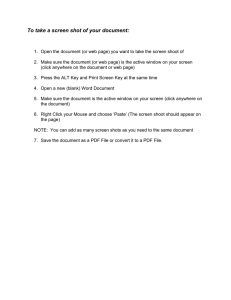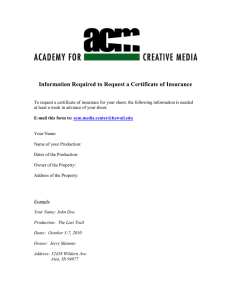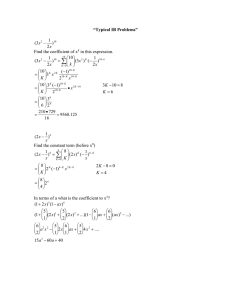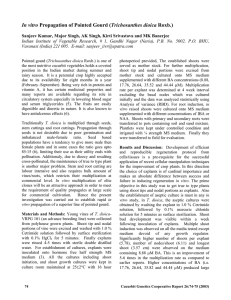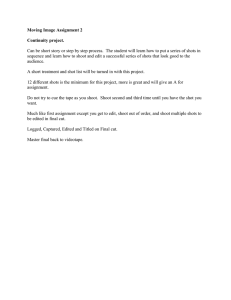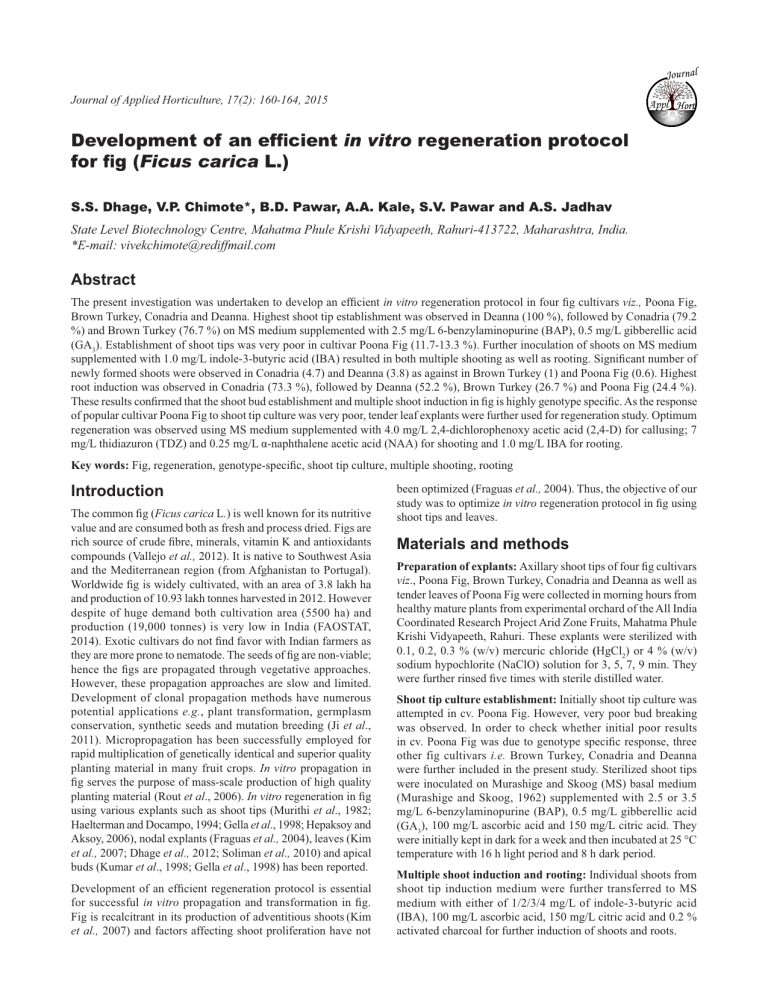
Journal Journal of Applied Horticulture, 17(2): 160-164, 2015 Appl 'HYHORSPHQWRIDQHIÀFLHQWin vitro regeneration protocol IRUÀJ Ficus carica L.) S.S. Dhage, V.P. Chimote*, B.D. Pawar, A.A. Kale, S.V. Pawar and A.S. Jadhav State Level Biotechnology Centre, Mahatma Phule Krishi Vidyapeeth, Rahuri-413722, Maharashtra, India. *E-mail: vivekchimote@rediffmail.com Abstract 7KHSUHVHQWLQYHVWLJDWLRQZDVXQGHUWDNHQWRGHYHORSDQHI¿FLHQWin vitroUHJHQHUDWLRQSURWRFROLQIRXU¿JFXOWLYDUVviz., Poona Fig, Brown Turkey, Conadria and Deanna. Highest shoot tip establishment was observed in Deanna (100 %), followed by Conadria (79.2 %) and Brown Turkey (76.7 %) on MS medium supplemented with 2.5 mg/L 6-benzylaminopurine (BAP), 0.5 mg/L gibberellic acid (GA3). Establishment of shoot tips was very poor in cultivar Poona Fig (11.7-13.3 %). Further inoculation of shoots on MS medium VXSSOHPHQWHGZLWKPJ/LQGROHEXW\ULFDFLG ,%$ UHVXOWHGLQERWKPXOWLSOHVKRRWLQJDVZHOODVURRWLQJ6LJQL¿FDQWQXPEHURI newly formed shoots were observed in Conadria (4.7) and Deanna (3.8) as against in Brown Turkey (1) and Poona Fig (0.6). Highest root induction was observed in Conadria (73.3 %), followed by Deanna (52.2 %), Brown Turkey (26.7 %) and Poona Fig (24.4 %). 7KHVHUHVXOWVFRQ¿UPHGWKDWWKHVKRRWEXGHVWDEOLVKPHQWDQGPXOWLSOHVKRRWLQGXFWLRQLQ¿JLVKLJKO\JHQRW\SHVSHFL¿F$VWKHUHVSRQVH of popular cultivar Poona Fig to shoot tip culture was very poor, tender leaf explants were further used for regeneration study. Optimum regeneration was observed using MS medium supplemented with 4.0 mg/L 2,4-dichlorophenoxy acetic acid (2,4-D) for callusing; 7 PJ/WKLGLD]XURQ 7'= DQGPJ/ĮQDSKWKDOHQHDFHWLFDFLG 1$$ IRUVKRRWLQJDQGPJ/,%$IRUURRWLQJ Key words: )LJUHJHQHUDWLRQJHQRW\SHVSHFL¿FVKRRWWLSFXOWXUHPXOWLSOHVKRRWLQJURRWLQJ ,QWURGXFWLRQ 7KHFRPPRQ¿J Ficus carica L.) is well known for its nutritive value and are consumed both as fresh and process dried. Figs are ULFKVRXUFHRIFUXGH¿EUHPLQHUDOVYLWDPLQ.DQGDQWLR[LGDQWV compounds (Vallejo et al., 2012). It is native to Southwest Asia and the Mediterranean region (from Afghanistan to Portugal). :RUOGZLGH¿JLVZLGHO\FXOWLYDWHGZLWKDQDUHDRIODNKKD and production of 10.93 lakh tonnes harvested in 2012. However despite of huge demand both cultivation area (5500 ha) and production (19,000 tonnes) is very low in India (FAOSTAT, ([RWLFFXOWLYDUVGRQRW¿QGIDYRUZLWK,QGLDQIDUPHUVDV WKH\DUHPRUHSURQHWRQHPDWRGH7KHVHHGVRI¿JDUHQRQYLDEOH KHQFHWKH¿JVDUHSURSDJDWHGWKURXJKYHJHWDWLYHDSSURDFKHV However, these propagation approaches are slow and limited. Development of clonal propagation methods have numerous potential applications e.g., plant transformation, germplasm conservation, synthetic seeds and mutation breeding (Ji et al., 2011). Micropropagation has been successfully employed for rapid multiplication of genetically identical and superior quality planting material in many fruit crops. In vitro propagation in ¿JVHUYHVWKHSXUSRVHRIPDVVVFDOHSURGXFWLRQRIKLJKTXDOLW\ planting material (Rout et al., 2006). In vitroUHJHQHUDWLRQLQ¿J using various explants such as shoot tips (Murithi et al., 1982; Haelterman and Docampo, 1994; Gella et al., 1998; Hepaksoy and Aksoy, 2006), nodal explants (Fraguas et al., 2004), leaves (Kim et al., 2007; Dhage et al., 2012; Soliman et al., 2010) and apical buds (Kumar et al., 1998; Gella et al., 1998) has been reported. 'HYHORSPHQWRIDQHI¿FLHQWUHJHQHUDWLRQSURWRFROLVHVVHQWLDO for successful in vitro SURSDJDWLRQDQGWUDQVIRUPDWLRQLQ¿J Fig is recalcitrant in its production of adventitious shoots (Kim et al., 2007) and factors affecting shoot proliferation have not been optimized (Fraguas et al., 2004). Thus, the objective of our study was to optimize in vitroUHJHQHUDWLRQSURWRFROLQ¿JXVLQJ shoot tips and leaves. Materials and methods Preparation of explants: $[LOODU\VKRRWWLSVRIIRXU¿JFXOWLYDUV viz., Poona Fig, Brown Turkey, Conadria and Deanna as well as tender leaves of Poona Fig were collected in morning hours from healthy mature plants from experimental orchard of the All India Coordinated Research Project Arid Zone Fruits, Mahatma Phule Krishi Vidyapeeth, Rahuri. These explants were sterilized with 0.1, 0.2, 0.3 % (w/v) mercuric chloride (HgCl2) or 4 % (w/v) sodium hypochlorite (NaClO) solution for 3, 5, 7, 9 min. They ZHUHIXUWKHUULQVHG¿YHWLPHVZLWKVWHULOHGLVWLOOHGZDWHU Shoot tip culture establishment: Initially shoot tip culture was attempted in cv. Poona Fig. However, very poor bud breaking was observed. In order to check whether initial poor results LQFY3RRQD)LJZDVGXHWRJHQRW\SHVSHFL¿FUHVSRQVHWKUHH other fig cultivars i.e. Brown Turkey, Conadria and Deanna were further included in the present study. Sterilized shoot tips were inoculated on Murashige and Skoog (MS) basal medium (Murashige and Skoog, 1962) supplemented with 2.5 or 3.5 mg/L 6-benzylaminopurine (BAP), 0.5 mg/L gibberellic acid (GA3), 100 mg/L ascorbic acid and 150 mg/L citric acid. They were initially kept in dark for a week and then incubated at 25 °C temperature with 16 h light period and 8 h dark period. Multiple shoot induction and rooting: Individual shoots from shoot tip induction medium were further transferred to MS medium with either of 1/2/3/4 mg/L of indole-3-butyric acid (IBA), 100 mg/L ascorbic acid, 150 mg/L citric acid and 0.2 % activated charcoal for further induction of shoots and roots. 'HYHORSPHQWRIDQHI¿FLHQWin vitroUHJHQHUDWLRQSURWRFROLQ¿J Ficus carica L.) 161 Table 1. Effect of growth regulators on in vitro shoot tip establishment Genotype Treatment Poona Fig Brown Turkey Conadria Deanna EM1 Establishment (%) 13.3 ±0.70 a Days to bud break/ sprouting 6.7 ±0.02 a Days to leaf emergence 7.6±0.03 Shoots with more than one leaf (%) 18.3 ±0.61 a Multiple shoot (%) 0.00 EM2 11.7 ±0.65 a 7.0±0.02 7.9±0.05 20.8 ±0.59 a 0.00 EM1 76.7±1.15 6.5±0.02 7. 5±0.03 90.8±0.85 0.00 EM2 53.3±0.48 6.7 ±0.03 a 7.3 ±0.04 a 52.5±0.83 0.00 EM1 79.2±0.59 6.1 ±0.01 b 7.1±0.04 EM2 87.5±1.26 bc EM1 100 EM2 62.5±0.50 6.2 ±0.03 95.0±1.96 52.50 a 60.8±0.49 39.17 7.3 ±0.02 a 94.2±0.99 41.67 a 54.2±0.48 60.00 7.2 ±0.02 6.2±0.03 c 6.4±0.03 7.3 ±0.03 2.08 0.07 0.103 2.75 CD at 5% EM1: MS + 2.5 mg/L BAP+ 0.5 mg/L GA3 + 100 mg/L ascorbic acid +150 mg/L citric acid EM2: MS + 3.5 mg/L BAP+ 0.5 mg/L GA3 + 100 mg/L ascorbic acid +150 mg/L citric acid *All values are means ±SE. Mean values in each column/row followed by the same lower-case letter(s) are not significantly different (P < 0.05) by the FCRD test.acid EM2: MS + 3.5 mg/L BAP+ 0.5 mg/L GA3 + 100 mg/L ascorbic acid +150 mg/L citric acid *All values are means ±SE. Mean values in each column/row followed by the same lower-case letter(s) are not significantly different (P < 0.05) by the FCRD test. In vitro regeneration using leaf explants in cv. Poona Fig: Tender leaves were cut across the midrib and placed with adaxial surface up for callusing on MS medium supplemented with six different hormonal combinations (Table 3) along with 100 mg/L ascorbic acid and 150 mg/L citric acid. They were initially kept in dark for a week and then incubated at 25 °C with 16 h light period and 8 h dark period. All treatments of regeneration experiments had three replicates with 25 explants in each replication. Nine weeks after culture, the calli were transferred to shooting medium i.e. MS medium with ten different hormonal combinations (Table 4). Subculturing of cultured material was done after every 4 weeks. Shoots were transferred to MS medium with 1.0 mg/L IBA for rooting. Plantlets thus produced were transferred to pots containing coco peat and farmyard manure (2:1), and irrigated with water at regular intervals. They were initially covered with plastic bags for a week and then kept in polycarbonated polyhouse. 5HVXOWVDQGGLVFXVVLRQ Preparation of explant: Contamination of axillary shoot tip and OHDIH[SODQWVZDVPDMRUSUREOHPLQ¿JGXULQJHVWDEOLVKPHQWRI in vitro culture. In all the genotypes tested 0.2 % HgCl2 for 7 min was found to be optimum for shoot tip sterilization. Though 0.2 % HgCl2 for 9 min gave highest sterilization but percent explant establishment was low. Decrease in concentration of disinfectant and duration of treatment resulted in high percentage of contamination while increase in concentration leads to browning of shoot tip. Sterilization with 0.1 % HgCl2 for 7 min was found to be optimum for leaf explants of Poona Fig. Higher HgCl 2 Table 2. Response of fig genotypes to multiple shoots and root induction Genotype Poona Fig Brown Turkey Conadria Deanna CD at 5% Treatment RM1 RM2 RM3 RM4 RM1 RM2 RM3 RM4 RM1 RM2 RM3 RM4 RM1 RM2 RM3 RM4 Rooting (%) 24.4±0.75a 0c 0c 0c 26.7±1.26b 0c 0c 0c 73.3±1.23 30±1.19 25.6±0.75ab 0c 52.2±0.63 0c 0c 0c 1.82 Shoot length (mm) 23.0±0.04a 14.0±0.04 23.0±0.03a 19.1±0.04 15.1±0.04 10.1±0.09 22.0±0.02 18.0±0.04 47.5±0.04 37.6±0.04 37.8±0.03 50.2 ±0.06 30.0±0.05 42.7±0.06 35.3±0.03 25.0±0.02 0.13 Number of leaves/ shoot 1.7±0.02a 1.0±0.02c 2.2±0.02 1.8 ±0.02a 1.8 ±0.03a 1.0 ±0.03c 2.3±0.03 1.8 ±0.02a 8.1±0.09 6.5±0.04 5.7±0.04b 5.7 ±0.04b 6.3±0.04 9.0±0.04 7.5±0.04 4.7±0.04 0.10 Newly formed shoots (#) 0.6±0.04b 0 0 0.5±0.02b 0.8±0.04 0 1.0±0.04 0 4.7±0.07 3.3±0.02 3.5±0.03 2.7±0.04 2.5±0.04 3.2±0.02 c 3.8±0.03 3.3±0.02 c 0.09 RM1: MS + 1 mg/L IBA, RM2: MS + 2 mg/L IBA, RM3: MS + 3 mg/L IBA, RM4: MS + 4 mg/L IBA *All values are means ±SE. Mean values in each column/row followed by the same lower-case letter(s) are not significantly different (P < 0.05) by the FCRD test. 162 'HYHORSPHQWRIDQHI¿FLHQWin vitroUHJHQHUDWLRQSURWRFROLQ¿J Ficus carica L.) concentrations (0.2-0.4 %) and 4 % NaClO proved to be more toxic leading to browning and death of leaf explants. (0-1.0 additional shoots/explant). Multiple shoots may be likely due to carry over effect of previous medium. Shoot tip culture establishment: Browning due to oxidation of phenolic compounds, released from the cut ends of the explants is a major problem during in vitro cultures of woody plant species. In preliminary experiments it was observed that browning of explants hindered explant establishment in cultivar Poona Fig. The shoot tips that survived showed poor growth in terms of shoot elongation and leaf emergence. There was high-browning in both shoot buds and leaf tissues. Therefore in the present study antioxidants such as ascorbic acid and citric acid were used in all medium to reduce browning. Soliman et al. (2010) used different antioxidants such as polyvinyl-pyrrolidone, citric acid and ascorbic acids to control browning. *HQRW\SHVSHFL¿FUHVSRQVHWR,%$WUHDWPHQWZDVREVHUYHGLQ terms of shoot length after 30 days of culture. Higher shoot length was observed in Conadria (37.6-50.2 mm) and Deanna (25.0-42.7 mm), as compared to Poona Fig (14.0-23.0 mm) and Brown Turkey (10.1-22.0 mm). Average number of leaves / shoots after 30 days of culture, was highest in Deanna (9.0) at 2 mg/L IBA followed by Conadria (8.1) at 1 mg/L IBA concentration. Even in other IBA treatments, high leaf bearing was observed in Conadria (5.7-6.5) and Deanna (4.7-7.5). However leaf bearing was very poor in Poona Fig (1.0-2.2) and Brown Turkey (1.0-2.3), with best treatment being 3 mg/L IBA in both cases. During shoot tip culture, it was observed that establishment of H[SODQWVZDVVLJQL¿FDQWO\LQÀXHQFHGE\JHQRW\SHDQGJURZWK regulator used (Table 1). Highest shoot tip establishment was observed on MS medium supplemented with 2.5 mg/L BAP and 0.5 mg/L GA3. However in Conadria optimum shoot tip establishment was observed on MS medium supplemented with 3.5 mg/L BAP and 0.5 mg/L GA3. Establishment was higher in three genotypes i.e. Deanna (62.5-100 %), Conadria (79.2-87.5 %) and Brown Turkey (53.3-76.7 %). However, response to shoot tip establishment was very poor in Poona Fig (11.7-13.3 %). BAP KDYHEHHQUHSRUWHGWREHXVHIXOLQ¿JVKRRWHVWDEOLVKPHQWDQG proliferation (Kumar et al., 1998; Kim et al., 2007). Mustafa and Taha (2012) reported enhanced shoot multiplication and callus IRUPDWLRQIURPVKRRWWLSH[SODQWVRIGLIIHUHQW¿JFXOWLYDUVXVLQJ 2.5 mg/L BAP. Hepaksoy and Aksoy (2006) used combination of BAP, GA3 and IBA for in vitro shoot tip culture as well as in PXOWLSOLFDWLRQPHGLXPLQ¿J*HQRW\SHVSHFL¿FUHVSRQVHGXULQJ in vitroFXOWXUHLQ¿JKDVDOVREHHQUHSRUWHGHDUOLHU +HSDNVR\DQG Aksoy, 2006; Kim et al., 2007; Dhage et al., 2012). Number of leaves per shoot also varied with genotype and culture medium used (Table 1). Cultivar Poona Fig showed poor leaf bearing with only 17.7 % shoots having multiple leaves as compared to other three genotypes (52.5-95 %). There was not much effect of genotype and growth regulator on days to bud sprouting (6.1-7.0 days) and leaf emergence (7.1-7.9 days). Earliest bud sprouting (6.1 days) and leaf emergence (7.1 days) was observed in Conadria genotype. Callus formation at the base was observed in Brown Turkey and Poona Fig after 12-16 days. Multiple shoot formation was observed only in Deanna (41.7 and 60.0 %) and Conadria (52.5 and 39.17%) at BAP concentrations of 2.5 mg/L and 3.5 mg/L, respectively with GA3 (0.5 mg/L). However, no multiple shooting was observed in genotype Poona Fig and Brown Turkey in either treatment. Shoot tip culture studies clearly indicated that Poona Fig was very poor in response to initial in vitro morphogenesis as compared to other genotypes. Multiple shoot induction and rooting: Individual shoots obtained from shoot tip culture were transferred to rooting medium containing four different IBA combinations (1-4 mg/L). However, multiples shoots were observed in addition to rooting. 5HVSRQVHWRVKRRWPXOWLSOLFDWLRQZDVKLJKO\JHQRW\SHVSHFL¿F (Table 2). Higher new shoot induction was observed in Conadria (2.7-4.7 additional shoots/explant) and Deanna (2.5-3.8 additional shoots/explant). Negligible new shoot induction was observed in Poona Fig (0-0.6 additional shoots/explant) and Brown Turkey Highest rooting percentage was observed in MS medium supplemented with 1 mg/L IBA in all genotypes i.e. Conadria (73.3 %), followed by Deanna (52.2 %), Brown Turkey (26.7 %) and Poona Fig (24.4 %) (Table 3). However, in Brown Turkey shoots exhibited only aerial rooting. Cultivar Conadria also showed significant rooting at 2 mg/L and 3 mg/L IBA concentrations. However, there was almost no rooting in rest of genotype-IBA treatment combinations. Earlier, there are reports RIURRWLQJLQ¿JDWYDU\LQJOHYHOVRI,%$i.e. 0.5 mg/L IBA and NAA (Danial et al., 2014); 1 mg/L IBA (Yakushiji et al., 2003; Soliman et al., 2010); 2 mg/L IBA (Kumar et al., 1998) and hormone free medium (Yakushiji et al., 2003; Kim et al., 2007). In vitro regeneration using leaf explants in cv. Poona Fig: Poona Fig is very popular local cultivar in western India due to its JRRGÀDYRUHDVLO\UHPRYDEOHVNLQDQGVRIWVHHGV+RZHYHUWKLV variety showed very poor response to shoot tip culture therefore OHDIH[SODQWVIURP¿HOGZHUHXVHGIRUUHJHQHUDWLRQVWXG\0RVW of the reports published are based on use of leaf explants derived IURPVKRRWWLSFXOWXUHLQ¿J <DNXVKLMLet al., 2003; Soliman et al., 2010; Dhage et al., 2012). Browning was observed in all media, of which least browning (18.7-28.0 %) was observed on medium containing only 2,4-dichlorophenoxy acetic acid (2,4-D), while highest incidence of browning (58.7-68.0 %) was observed on both combinations RI%$3DQGĮQDSKWKDOHQHDFHWLFDFLG 1$$ 'D\VUHTXLUHGIRU callus treatments also varied with treatments, ranging from 35.345.7 days. Late callus formation (48.3-49.0 days) was observed on medium containing combinations of kinetin and 2,4-D. Among all treatments, calli induction frequency varied from 21.3 % to 89.3 % (Table 3). Highest (89.3 %) and earliest callus Table 3. Callus formation in cv. Poona Fig after 60 days of inoculation Hormonal concentration (mg/L) BAP NAA 8.0 8.0 10 .0 10.0 2,4-D Kinetin 2.0 0 2.0 0.2 4.0 0 4.0 0.4 LSD (P=0.05) Callusing (%) Browning Days to callus (%) initiation 21.3±0.92 60.0±1.64 68.0±1.4 58.7±0.77 45.7±0.88 40.3±0.88 a 66.7 ±1.32 28.0±1.5 41.7 ±0.33 a 48.0±1.64 40.0±1.4 49.0±0.58 b 89.3±2.38 18.7±0.99 35.3±0.33 41.3±0.77 41.3±0.77 48.3 ±0.33 b 4.75 3.60 1.87 *All values are means ±SE. Mean values in each column/row followed by the same lower-case letter(s) are not significantly different (P < 0.05) by the CRD test. 'HYHORSPHQWRIDQHI¿FLHQWin vitroUHJHQHUDWLRQSURWRFROLQ¿J Ficus carica L.) 163 induction was observed when leaf explants were cultured on MS medium supplemented with 4.0 mg/L 2,4-D. Next highest calli formation (66.7 %) was observed on medium containing 2.0 mg/L 2,4-D. This is as expected since it is well known that 2,4-D serves as a callusing agent at higher concentrations. Addition of NLQHWLQUHVXOWHGLQVLJQL¿FDQWUHGXFWLRQRIFDOOXVLQJDQGLQFUHDVH in browning at both 2,4-D concentrations. This result contradicts earlier reports of Soliman et al. (2010) of higher callus formation (86%) obtained on MS medium supplemented with 2 mg/L 2,4-D and 0.2 mg/L kinetin. Sixty per cent callusing was observed on MS medium supplemented with 10.0 mg/L BAP and 10.0 mg/L NAA. Lowest callus formation (21.33 %) was observed on medium supplemented with 8.0 mg/L BAP and 8.0 mg/L NAA. Previously, Soliman et al. (2010) reported 73 and 68% callusing, respectively on MS medium with 10.0 mg/L BAP and NAA each and 8.0 mg/L BAP and NAA each. For shoot induction ten different medium were used, out of which VKRRWLQGXFWLRQZDVREVHUYHGRQO\LQ¿YHRIWKHPWKUHHRIZKLFK were supplemented with thidiazuron (TDZ) and NAA (Table 4). These three NAA and TDZ combinations showed earliest shooting (26.0-35.7 days); longest shoot length (19.2-22.3 mm); most shoots/ callus (2.4-2.8). Highest shoot induction (82.7 %) was observed in MS medium supplemented with 7.0 mg/L TDZ DQGPJ/1$$7'=KDVEHHQUHSRUWHGWREHHI¿FLHQWLQ stimulating adventitious shoot production in several recalcitrant ZRRG\SODQWVLQFOXGLQJ¿J(Huetteman and Preece, 1993). Soliman et al. (2010) reported optimum indirect shooting on medium comprising 7 mg/L TDZ in combination with 0.25 mg/L NAA. Shooting was also observed in MS medium supplemented with 8.0 mg/L N6-[2-Isopentyl] adenine (2iP) + TDZ 2.0 mg/L and 8.0 mg/L BAP + 2.0 mg/L kinetin. Later treatment showed delayed shooting (44 days), poor shoot growth (12.2 mm) and lowest multiples (1.3). High browning was observed in the treatments that failed to induce shoot. After shooting for 4-5 weeks regenerated shoots were rooted on full-strength MS medium with 1 mg/L IBA and acclimatized into pots containing cocopeat and manure in polycarbonate polyhouse. ,QVXPPDU\KLJKO\HI¿FLHQWVKRRWPXOWLSOLFDWLRQDQGUHJHQHUDWLRQ Table 4. Details of shoot induction from calli of cv. Poona Fig Hormonal Percent concentration shoot ( mg/L) induction NAA TDZ 0.25 7.0 82.7±0.99 0.50 7.0 64.0±1.38 0.25 8.0 25.3±2.31 a 2iP TDZ 8.0 2.0 45.3±2.03 10.0 2.0 0.0 20.0 2.0 0.0 2iP 30.0 0.0 BAP Kinetin 8.0 2.0 22.7±0.92a 8.0 4.0 0.0 10.0 2.0 0.0 3.39 LSD (P=0.05) Days to shoot induction Shoot length (mm) Number of shoots/ explant 30.7±0.88 20.2±0.09 2.8±0.15 26.0±0.58 22.3±0.09 2.5±0.09a 35.7±0.88 19.2±0.09 2.4±0.06 a 41.0±0.58 21.6±0.09 0.0 0.0 0.0 0.0 0.0 0.0 44.0±0.58 12.2±0.12 0.0 0.0 0.0 0.0 2.25 0.30 2.0±0.06 0.0 0.0 0.0 1.3±0.06 0.0 0.0 0.28 Fig. 1. In vitro regeneration in fig. (A) Shoot tip establishment on MS+2 mg/L BAP + 0.5 mg/L GA3 in Conadria; (B) Multiple shoot induction MS + 1 mg/L IBA in Conadria; (C) Rooting; (D) Aerial rooting in cv. Brown Turkey:; (E): Callus initiation from cv. Poona Fig leaf explant on 4 mg/L 2,4-D; (F): Shoot induction from the callus on MS + 0.25 mg/L NAA + 7 mg/L TDZ in cv. Poona Fig. protocol was developed. Shoot bud breaking at 2.5-3.5 mg/L BAP + 0.5 mg/L GA3 and further inoculation at 1.0 mg/L IBA resulted in multiple shooting as well as rooting. Best regeneration was observed after callusing from leaf explants on 4.0 mg/L 2, 4 D followed by subsequent shooting on 7 mg/L TDZ and 0.25 mg/L NAA. The present investigation may be helpful for commercial PLFURSURSDJDWLRQRIGLIIHUHQWYDULHWLHVRI¿J Acknowledgements The authors are grateful to authorities of Mahatma Phule Krishi Vidyapeeth, Rahuri for providing necessary facilities to undertake WKLVVWXG\+HOSUHQGHUHGE\'U966XSH2I¿FHU,QFKDUJH All India Coordinated Research Project on Arid Zone Fruits, Mahatma Phule Krishi Vidyapeeth, Rahuri, India during this study is also gratefully acknowledged. 164 'HYHORSPHQWRIDQHI¿FLHQWin vitroUHJHQHUDWLRQSURWRFROLQ¿J Ficus carica L.) References Danial, G.H., D.A. Ibrahim, S.A. Brkat and B.M. Khalil, 2014. Multiple VKRRWVSURGXFWLRQIURPVKRRWWLSVRI¿JWUHH Ficus carica L.) and callus induction from leaf segments. Intl. J. Pure Appl. Sci. Tech., 20(1): 117-124. Dhage, S.S., B.D. Pawar, V.P. Chimote, A.S. Jadhav and A.A. Kale, 2012. In vitroFDOOXVLQGXFWLRQDQGSODQWOHWUHJHQHUDWLRQLQ¿J Ficus carica L.). J. Cell Tiss. Res., 12: 3395-3400. FAOSTAT, 2014. http://faostat3.fao.org/browse/Q/QC/E Fraguas, C.B., M. Pasqual, L.F. Dutra and J.O. Cazetta, 2004. 0LFURSURSDJDWLRQRI¿J Ficus carica L.) ‘roxo de valinhos’ plants. In vitro Cell. Dev. Biol. Plant, 40: 471-474. Gella, R., J.A. Marin, M.L. Corrales and F. Toribio, 1998. Elimination RI ¿J PRVDLF IURP ¿J VKRRW WLS FXOWXUHV E\ WKHUPRWKHUDS\ Acta Hort., 480: 173-177. Haelterman, R.M. and D.M. Docampo, 1994. In vitro propagation of PRVDLFIUHH ¿J Ficus carica L.) cultivars, using thermotherapy and shoot tip cultures. Revista de Investigaciones Agropecuarias, 25(3): 15-22. Hepaksoy, S. and U. Aksoy, 2006. Propagation of Ficus carica L. clones by in vitro culture. Biol. Plant., 50: 433-436. Huetteman, C.A. and J.E. Preece, 1993. Thidiazuron: A potent cytokinin for woody plant tissue culture. Plant Cell Tiss. Org. Cult., 33: 105119. Ji, A., X. Geng, Z. Yan, H. Yang and G. Wu, 2011. Advances in somatic embryogenesis research of horticultural plants. Amer. J. Plant Sci., 2: 727-732. Kim, K.M., M.Y. Kim, P.Y. Yun, T. Chandrasekhar, H.Y. Lee and P.S. Song, 2007. Production of multiple shoots and plant regeneration IURP OHDI VHJPHQWV RI ¿J WUHH Ficus carica L.). J. Plant Biol., 50(4): 440-446. Kumar, V., A. Radha and S.K. Chitta, 1998. In vitro plant regeneration of ¿J Ficus carica L. cv. Gular) using apical buds from mature trees. Plant Cell Rep., 17: 717-720. Murashige, T. and F. Skoog, 1962. A revised medium for rapid growth and bioassays with tobacco tissue culture. Physiol. Plant., 15: 473-497. Murithi, L.M., T.S. Rangan and B.H. Waite, 1982. In vitro propagation RI¿JWKURXJKVKRRWWLSFXOWXUHHortScience, 17: 86-87. 0XVWDID16DQG5$7DKD,QÀXHQFHRISODQWJURZWKUHJXODWRUV and subculturing on in vitroPXOWLSOLFDWLRQRIVRPH¿J Ficus carica) cultivars. J. Appl. Sci. Res., 8(8): 4038-4044. Rout, G.R., A. Mohapatra and M.S. Jain, 2006. Tissue culture of ornamental pot plant: A critical review on present scenario and future prospects. Biotechnol. Adv., 24: 531-560. 6ROLPDQ+,0*DEUDQG1$EGDOODK(I¿FLHQWWUDQVIRUPDWLRQ DQGUHJHQHUDWLRQRI¿J Ficus carica L.) via somatic embryogenesis. GM Crops, 1: 47-58. Vallejo, F., J.G. Marin and F.A. Tomas-Barberan, 2012. Phenolic FRPSRXQGFRQWHQWRIIUHVKDQGGULHG¿JV Ficus carica L.). Food Chem., 130: 485-492. Yakushiji, H., N. Mase and Y. Sato, 2003. Adventitious bud formation DQG SODQWOHW UHJHQHUDWLRQ IURP OHDYHV RI ¿J Ficus carica L.). J. Hort. Sci. Biotech., 78: 874-878. Submitted: October, 2014; Revised: December, 2014; Accepted: January, 2015
